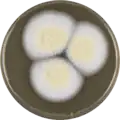| Aspergillus persii | |
|---|---|
| Scientific classification | |
| Domain: | Eukaryota |
| Kingdom: | Fungi |
| Division: | Ascomycota |
| Class: | Eurotiomycetes |
| Order: | Eurotiales |
| Family: | Aspergillaceae |
| Genus: | Aspergillus |
| Species: | A. persii |
| Binomial name | |
| Aspergillus persii A.M. Corte & Zotti 2002[1] | |
| Type strain | |
| CBS 112795, IBT 22660, MUCL 41970[2] | |
Aspergillus persii is a species of fungus in the genus Aspergillus which can cause onychomycosis.[1][2][3] and otomycosis[4]
It is from the Circumdati section.[5] Aspergillus persii produces xanthomegnin and ochratoxin A.[6][7][8]
Growth and morphology
A. persii has been cultivated on both Czapek yeast extract agar (CYA) plates and Malt Extract Agar Oxoid® (MEAOX) plates. The growth morphology of the colonies can be seen in the pictures below.
 Aspergillus persii growing on CYA plate
Aspergillus persii growing on CYA plate Aspergillus persii growing on MEAOX plate
Aspergillus persii growing on MEAOX plate
References
- 1 2 "Aspergillus persii". www.mycobank.org.
- 1 2 "Aspergillus persii". www.uniprot.org.
- ↑ Zotti, M; Machetti, M; Perotti, M; Barabino, G; Persi, A (June 2010). "A new species, Aspergillus persii, as an agent of onychomycosis". Medical Mycology. 48 (4): 656–60. doi:10.3109/13693780903420641. PMID 20055738.
- ↑ Merad, Yassine; Adjmi-Hamoudi, Haiat; Cassaing, Sophie; Mehadji, Mohamed; Berry, Antoine (2016-03-01). "Première description d'Aspergillus persii en tant qu'agent d'otomycose : à propos de trois cas, dans deux différentes villes d'Algérie". Journal de Mycologie Médicale. 26 (1): 70. doi:10.1016/j.mycmed.2016.02.010. ISSN 1156-5233.
- ↑ Visagie, C.M.; Varga, J.; Houbraken, J.; Meijer, M.; Kocsubé, S.; Yilmaz, N.; Fotedar, R.; Seifert, K.A.; Frisvad, J.C.; Samson, R.A. (2014). "Ochratoxin production and taxonomy of the yellow aspergilli (Aspergillus section Circumdati)". Studies in Mycology. 78: 1–61. doi:10.1016/j.simyco.2014.07.001. PMC 4255584. PMID 25492980.
- ↑ Dijksterhuis, Jan; Samson, Robert A. (2007). Food Mycology: A Multifaceted Approach to Fungi and Food. CRC Press. ISBN 9781420020984.
- ↑ Saeger, Sarah De (2011). Determining Mycotoxins and Mycotoxigenic Fungi in Food and Feed. Elsevier. ISBN 9780857090973.
- ↑ Anke, Timm; Weber, Daniela (2009). Physiology and Genetics: Selected Basic and Applied Aspects. Springer Science & Business Media. ISBN 9783642002861.
Further reading
- Kim, Jung A.; Jeon, Jongbum; Park, Sook-Young; Kim, Ki-Tae; Choi, Gobong; Nguyen, Hoa Thi; Jeon, Sun Jeong; Lee, Hyang Burm; Bae, Chang-Hwan; Yang, Hee-sun; Yeo, Joo-Hong; Kim, Jin-Cheol; Lee, Yong-Hwan; Kim, Soonok (21 September 2017). "Draft Genome Sequence of Aspergillus persii NIBRFGC000004109, Which Has Antibacterial Activity against Plant-Pathogenic Bacteria". Genome Announcements. 5 (38): e00932–17. doi:10.1128/genomeA.00932-17. PMC 5609410. PMID 28935731.
- "Aspergillus persii | Aspergillus & Aspergillosis Website". www.aspergillus.org.uk.
- "Aspergillus persii | Aspergillus & Aspergillosis Website". www.aspergillus.org.uk.
- Lamoth, Frederic; Steinbach, William J. (2016). Advances in Aspergillus fumigatus pathobiology. Frontiers Media SA. ISBN 9782889197897.
This article is issued from Wikipedia. The text is licensed under Creative Commons - Attribution - Sharealike. Additional terms may apply for the media files.